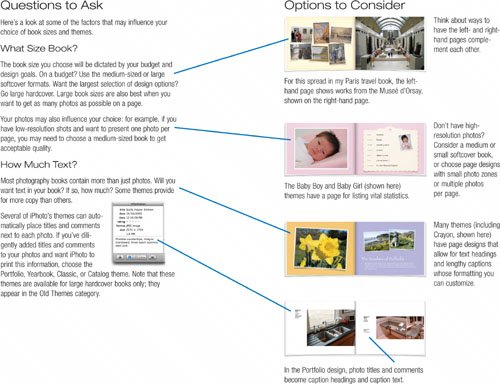Planning for Publishing
| A book project doesn't begin in a page-layout program. It begins with an author who has something to say, and with photo editors and designers who have ideas about the best ways to say it. When you create a photo book, you wear all of those hats. iPhoto works hard to make you look as fetching as possible in each of them, but you can help by putting some thought into your book before you click the Book button. What do you want your book to say? Is it commemorating an event? Or is it celebrating a person, place, or thing? Does the book need a story arca beginning, a middle, and an ending? Would the book benefit from distinct sectionsone for each place you visited, for example, or one for each member of the family? And no publishing project occurs without a discussion of production expenses. Is money no object? Or are you pinching pennies? Your answers to these questions will influence the photos you choose, the book designs you use, and the way you organize and present your photos and any accompanying text. The very best time to address these questions isn't before you start your bookit's before you start shooting. If you have a certain kind of book in mind, you can make sure you get the shots you need. Here's more food for thought. Figure . What Design Options? Each book size and type provides its own set of themes. Each theme has its own design options, including different color schemes; different ways to arrange photos on each page; and special photo effects, such as collages.  One Side Or Two? When creating a large-sized hardcover bookalso called a Keepsake bookyou can choose between single- or double-sided pages. With double-sided pages, you get two-page spreads like those shown at left. With single-sided pages, the left-hand page in each spread is blank. Given that all commercially published books have double-sided pages, why would you choose a single-sided format? One reason might be if you plan to print the book yourself using iPhoto's Print command (page 192). You can't print on both sides of a sheet of photo paper, so a single-sided scheme makes more sense. A double-sided layout give you more design options. Large softcover books are always double-sided, as are medium- and small-sized books. What is a Page, Anyway? With all book sizes, you pay a per-page fee for each additional page beyond 20 (page 185). A "page" isn't a sheet of paperit's anything with ink on it. For example, a book containing 20 double-sided pages contains ten sheets of paper. With large hardcover books, the per-page pricing can seem confusing. If you opt for a single-sided layout, your $29.99 buys you ten pages; each additional page is $1.49. If you go double-sided, you get 20 pages (ten sheets of paper), and each extra page costs $.99. Got all that? Don't worry. iPhoto calculates your final price when you order your book. |
